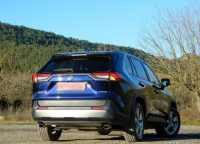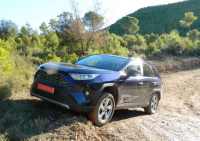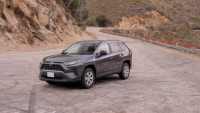The importance of the Toyota RAV4 model is hard to overestimate: its name is like a synonym of the word "success" in the automobile market. In fact, having founded the "class named after itself" back in 1994, the Toyota RAV4 crossover has been one of the unchanged leaders and bestsellers in this segment for a quarter of a century - about 9 million copies have been sold. But will the novelty be able to repeat successes of its predecessors? How will the new, fifth generation Toyota RAV4 attract buyers against the background of more and more different competitors? I will try to answer in the format of "first sight" from all-European test drive.
The new generation RAV4 - what's new about it?
Platform, dimensions, design, construction. The fifth-generation Toyota RAV4 is built on the proprietary TNGA global architecture: in this case, it uses the "middle" TNGA GA-K platform, which was previously found in the Toyota Camry sedan. In general, the TNGA architecture is aimed at overall comprehensive improvement of the car - low center of gravity, lighter construction, stiffer body (+57% compared to the last generation). Plus optimal use of every millimeter of space. Thus, the new crossover Toyota RAV4 became even a little bit shorter than its forerunner: length - 4 600 mm (- 5 mm). Although the width, on the contrary, increased - now 1 855 mm (+10 mm). The height is 1 685 mm. However, the wheelbase has grown most of all - now 2,690 mm (+30 mm): this was achieved by reducing the front and rear overhangs. The ground clearance is 190-195 mm, depending on the car version and engine type.
 A brief description for the new generation of the Toyota RAV4: the car has become more muscular and collected. We want to write "the car has become more masculine": sharp lines, highlighted wheel arches, narrow headlights, dashing slope of the rear pillar. Reduced length promises ease of maneuvering in a cramped city. On the contrary: the wheelbase is increased - which had a positive impact on the spaciousness of the cabin. The trunk has also increased: now 580 liters for the hybrid version, which is 79 liters more than its hybrid predecessor. For the first time for Toyota RAV4 - the car is available in two-color version with black roof.
A brief description for the new generation of the Toyota RAV4: the car has become more muscular and collected. We want to write "the car has become more masculine": sharp lines, highlighted wheel arches, narrow headlights, dashing slope of the rear pillar. Reduced length promises ease of maneuvering in a cramped city. On the contrary: the wheelbase is increased - which had a positive impact on the spaciousness of the cabin. The trunk has also increased: now 580 liters for the hybrid version, which is 79 liters more than its hybrid predecessor. For the first time for Toyota RAV4 - the car is available in two-color version with black roof.
Japanese attention to details is impressive. Thus, according to statements of the company representatives, there was a very careful work on weight distribution: not only between the front and rear axles (51/49%), but also between the left and right wheels - to achieve an even load they even had to slightly change the location of the fuel tank. The electric power steering motor was moved from the steering column to the rack - in order to improve control clarity and "natural" force on the steering wheel. The above-mentioned trunk, in addition to increasing the volume, is also better organized: pockets for small things, double-sided floor (tufted coating and plastic cover for dirty things), hooks for bags. Another example: the low location of the engine lowered the hood line by 15 mm - which, in turn, provided an increased viewing angle for the driver. Thin body pillars and a "lower" dashboard interior also contributed to the same task. Thanks to such methods the cabin is literally filled with sunlight, which psychologically affects the perception of space.
 And as a whole - the interior has changed greatly. The front panel now really seems lower: you see a plateau of soft plastic in front of you, where towers of the central display and dashboard are towering. At times the trimming and forms seem rough - simple central part of a steering wheel (though there is pleasant leather on a rim), massive door handles, huge pucks of "climate" supported by silver trimming from the beginning of 2000s. And when a front passenger sits "waddling" his left knee will press against the central console. But if to remember the appearance of the car - I admit, that it is 100% hit in one image. If to study details, it turns out that the novelty is not so simple: here are devices with the big central color display instead of usual analogue speedometer, here are seats with developed "lugs" of lateral support and 3 steps ventilation. Much attention is paid to rear passengers - it is a family car: it became more spacious, there are deflectors of ventilation, adjustment of backrest angle, heating.
And as a whole - the interior has changed greatly. The front panel now really seems lower: you see a plateau of soft plastic in front of you, where towers of the central display and dashboard are towering. At times the trimming and forms seem rough - simple central part of a steering wheel (though there is pleasant leather on a rim), massive door handles, huge pucks of "climate" supported by silver trimming from the beginning of 2000s. And when a front passenger sits "waddling" his left knee will press against the central console. But if to remember the appearance of the car - I admit, that it is 100% hit in one image. If to study details, it turns out that the novelty is not so simple: here are devices with the big central color display instead of usual analogue speedometer, here are seats with developed "lugs" of lateral support and 3 steps ventilation. Much attention is paid to rear passengers - it is a family car: it became more spacious, there are deflectors of ventilation, adjustment of backrest angle, heating.

 Completely new interior architecture: the front panel has become lower, the central display is now separate, the "climate" unit clearly stands out. Some coarseness of the interior echoes well with the general "assertive" design of the car. If to consider details - the car is not so simple: front seats with the developed lateral support, in back width is increased and there is more space for legs, the accurate block of switching of driving modes (Normal, Eco, Sport, plus new mode Trail), the allocated button EV Mode for transfer of a hybrid into electric car mode.
Completely new interior architecture: the front panel has become lower, the central display is now separate, the "climate" unit clearly stands out. Some coarseness of the interior echoes well with the general "assertive" design of the car. If to consider details - the car is not so simple: front seats with the developed lateral support, in back width is increased and there is more space for legs, the accurate block of switching of driving modes (Normal, Eco, Sport, plus new mode Trail), the allocated button EV Mode for transfer of a hybrid into electric car mode.
Was there only a hybrid on the test drive?
No, not only, but the hybrid versions were the vast majority. If the name RAV4 is synonymous with "success," but the word "hybrid" is synonymous with the Toyota brand. To understand the importance of hybrid technology: the hybrid version of RAV4 occupied 85% (!) of total sales of the model on the European market. The hybrid "went" in Ukraine as well: it occupied about a half of the total sales of the model. Actually, the hybrid Toyota RAV4 replaces diesel engines that were so much loved in Europe a couple of years ago. From experience with other Toyota hybrids - the C-HR, for example - we can say that the hybrid really allows you to drive with diesel consumption, plus offers increased power and dynamics, as well as the ability to drive through traffic on electric power alone (yep, that EV Mode button).
With the release of the new generation Toyota RAV4, the manufacturer expects that the share of hybrids will even reach 90% in total sales of the model for the pan-European market. The reason for such statements is the significant improvement of the hybrid technology, where every detail has changed. The overall design is known from the last generation of Toyota RAV4 Hybrid: gasoline engine and electric motor to drive the front wheels, a four-wheel drive version uses another electric motor to drive the rear, a small NiMH traction battery is located near the second row of seats. But every key component in this layout has been changed!
For example, the 2.5-liter four-cylinder gasoline engine A25A-FXS of the Dynamic Force family is now completely new: combined D-4S fuel injection, 14:1 compression ratio, inlet and outlet variable valve timing. Already traditional for hybrids, the engine runs on the Atkinson (Miller) cycle. Together with the gasoline engine the 3NM electric motor with a capacity of 88 kW (120 hp) works. The total output of hybrid power plant reaches 218 hp or 160 kW. The all-wheel drive version also gets an electric motor to drive the rear wheels: the 4NM series and a maximum output of 40 kW (54 hp), the maximum torque at the rear wheels can reach 1,300 Nm, which is 30% more than its predecessor (953 Nm). The Toyota RAV4 Hybrid with AWD-i all-wheel-drive is slightly higher at 222 hp or 163 kW. Depending on the different modes of different motors, the all-wheel-drive hybrid gets torque distribution between the front/rear axles in the proportion from "100:0" to "20:80". The electronic components of the hybrid have also changed - the PCU (Power Control Unit) and traction battery reduced in size and became lighter (-11% for the battery). By the way, the battery type NiMH (nickel metal hydride), works with a nominal voltage of 245 volts (maximum in the hybrid system can reach 650 volts), its capacity is 6.5 Ah.
 The new generation Toyota RAV4 Hybrid opens up a new level of power: 218-222 hp, depending on the type of drive (versus 197 hp for the predecessor). Top speed - 180 km / h (equally for versions with front or all-wheel drive), acceleration 0-100 km / h is promised for 8.1-8.4 seconds, the mixed fuel consumption - 4.4-4.6 liters per 100 kilometers of travel (the last two parameters depending on the type of drive). Hybrid technology is completely renewed: a new gasoline engine, more traction for the rear wheels, smaller and lighter traction battery. Any of the usual transmissions is missing: here we use a proprietary hybrid unit based on a planetary gear with a gear ratio of 3.605 - for the end buyer this system is perceived as an "automatic".
The new generation Toyota RAV4 Hybrid opens up a new level of power: 218-222 hp, depending on the type of drive (versus 197 hp for the predecessor). Top speed - 180 km / h (equally for versions with front or all-wheel drive), acceleration 0-100 km / h is promised for 8.1-8.4 seconds, the mixed fuel consumption - 4.4-4.6 liters per 100 kilometers of travel (the last two parameters depending on the type of drive). Hybrid technology is completely renewed: a new gasoline engine, more traction for the rear wheels, smaller and lighter traction battery. Any of the usual transmissions is missing: here we use a proprietary hybrid unit based on a planetary gear with a gear ratio of 3.605 - for the end buyer this system is perceived as an "automatic".
However, the hybrid described above is not the only power unit for the new generation of the Toyota RAV4. In fact, for some markets in Europe, the conventional gasoline atmospheric 2-liter four-cylinder engine M20A-FKS will also be offered. Although the word "usual" is not quite fair: combined fuel injection D-4S, high compression ratio of 13:1, dual (intake/exhaust) variable valve timing system. This engine develops 173-175 hp (depending on how you measure) and 208 Nm, the claimed combined fuel consumption - 5.6-6.4 liters per 100 kilometers, depending on the type of drive and gearbox.
Moreover, the last specification is not accidental, as in the 2-liter versions the variety of transmission is attractive: 6-step. "mechanics" or "automat" (CVT-variator), front or a full drive. And again Toyota has prepared a lot of interesting, unusual solutions for RAV4. Thus, CVT-variator Direct Shift is used as "automatic" in which the real mechanical first gear is provided - it will be useful for driving on lack of roads and slipping in mud without risk for "guts" of a variator. Also the full drive Dynamic Toque Vectoring is interesting: it is a system of active redistribution of torque by means of two frictional clutches - separately for each rear wheel.
So, how does it drive? Power, dynamics, comfort, handling...
During the test drive it was possible to drive only hybrid versions of Toyota RAV4. But in different versions and conditions: front or full drive, high-speed highway, serpentines, light off-road. And as a whole - it is quite worthy! Although, I admit, without much revelation in the question of controllability or dynamics: the first impressions, the new 220-horsepower crossover is not far from the level of dynamics of the last Toyota RAV4 Hybrid - but in fact the latter was quite "chipper" for its class and format. Comparison of dynamics of acceleration from 0 to 100 km/h also puts all the points above "i": comparable 8,1-8,5 seconds. Also the mode Sport does not make a sports car from a crossover: a steering wheel becomes appreciably heavier, the engine more often works in high revolutions zone (and it is heard), the display of the dashboard becomes red. But these are only hints, but not real change of car's character.
 The driving mode switch changes not only the settings of the motor, steering, display color, but also its backlighting - original! Hybrids always have EV Mode button: forced transfer of the system to electric traction: for a small traffic jam or passing through the yards will suffice. In all-wheel drive versions there is also a special mode "Trail Mode": selective braking of wheels to imitate an interwheel differential.
The driving mode switch changes not only the settings of the motor, steering, display color, but also its backlighting - original! Hybrids always have EV Mode button: forced transfer of the system to electric traction: for a small traffic jam or passing through the yards will suffice. In all-wheel drive versions there is also a special mode "Trail Mode": selective braking of wheels to imitate an interwheel differential.
Really the whole essence of Toyota RAV4 Hybrid is that it is the most universal car for real life: it reveals itself at a soft or medium pace of driving, there is a huge emphasis on the comfort of the suspension. In this case, hybrid transients are hardly noticeable: press the gas pedal - the car goes forward, there is enough traction at low and medium revs, and there is little or no noise from the engine. And the steering wheel is good: with moderate sharpness (a little bit less than 3 revolutions from stop to stop), easy at low and average speeds. On rare holes and hillocks of Spanish roads, the crossover as much as possible rounds and "dissolves" almost all irregularities: partly in suspension, partly in thick tires. Also - the suspension is good on light lack of roads. However, another thing has surprised me more: it is the first "civilian" four-wheel drive hybrid in my memory that has enough capacity of a back electric motor!
Relatively small weight and increased torque (relative to the last generation) have led to the fact that now there is enough traction to push the car off-road or "give the gas" when exiting a turn on the unpaved road. If to add to it the power absorbing suspension - the crossover lack of roads stops: power enough, softness enough... But sometimes there is not enough moves of a suspension: it is possible to move a wheel out even on an average slope. Also the front bumper with a protruding lip seemed too low - sometimes we had to be careful. Certainly, all it concerns only the version with AWD-i full hybrid drive, the way to the cross-country track for front-wheel drive hybrid was closed. It is the off-road capability that is the main difference between the two. Otherwise, dynamics and acceleration are very similar, only sometimes wheel slippage is appreciable - at sharp start on unpaved or asphalt with sand and rubble. It is a pity, but how the 2-liter version with traditional all-wheel drive behaves I cannot tell at all now.
 In one phrase: everything that you expect from a crossover like Toyota RAV4 on a light off-road, it fulfills without problems and with pleasure. But more is the territory of pickups and SUVs. The clearance of the hybrid is 190mm, and angles of entrance/departure make 17,5/20 degrees. But these are the data for the European version of the car, and the crossover can come to Ukraine with a little bit changed suspension and/or on the tires of another dimension - as a result the clearance and angles of approach will be changed.
In one phrase: everything that you expect from a crossover like Toyota RAV4 on a light off-road, it fulfills without problems and with pleasure. But more is the territory of pickups and SUVs. The clearance of the hybrid is 190mm, and angles of entrance/departure make 17,5/20 degrees. But these are the data for the European version of the car, and the crossover can come to Ukraine with a little bit changed suspension and/or on the tires of another dimension - as a result the clearance and angles of approach will be changed.
OK, I understand in general. And what about the details: equipment, functions, systems?
The new generation of the Toyota RAV4 crossover has also received a new generation of the company's TSS (Toyota Safety Sense) technology - already the second in a row. In general, TSS is a set of various systems and functions to help the driver while driving: lane control, adaptive "cruise", emergency braking. Now the complex TTS has been redesigned, the number of available functions has been expanded: for example, the system of emergency braking learned to recognize cyclists, added recognition of pedestrians at night, active lane control is able to "adjust" the car within its lane. Adaptive Cruise Control is now "intelligent" (iACC, intelligent Adaptive Cruise Control): it works in tandem with the function of recognizing road signs and gives tips-recommendations on the permitted speed. Such improvements and extensions of functionality became possible due to the new "senses" of the car: the radar in the radiator grille and the review camera. In addition, the novelty received a JBL audio system (9 speakers) and a "smart" rear-view mirror: in fact, an LCD screen that displays the picture from the rear-view camera.
 The new crossover Toyota RAV4 has also received a new TTS (Toyota Safety Sense) system - already of the second generation: there is recognition of cyclists, pedestrian detection is improved, adaptive cruise control has become "smart". The rear-view mirror can now hide an LCD screen to view the situation behind the car: no more problems with the trunk, loaded to the roof. Also the novelty can offer wireless charging for a smartphone, several USB ports, all-around visibility.
The new crossover Toyota RAV4 has also received a new TTS (Toyota Safety Sense) system - already of the second generation: there is recognition of cyclists, pedestrian detection is improved, adaptive cruise control has become "smart". The rear-view mirror can now hide an LCD screen to view the situation behind the car: no more problems with the trunk, loaded to the roof. Also the novelty can offer wireless charging for a smartphone, several USB ports, all-around visibility.



